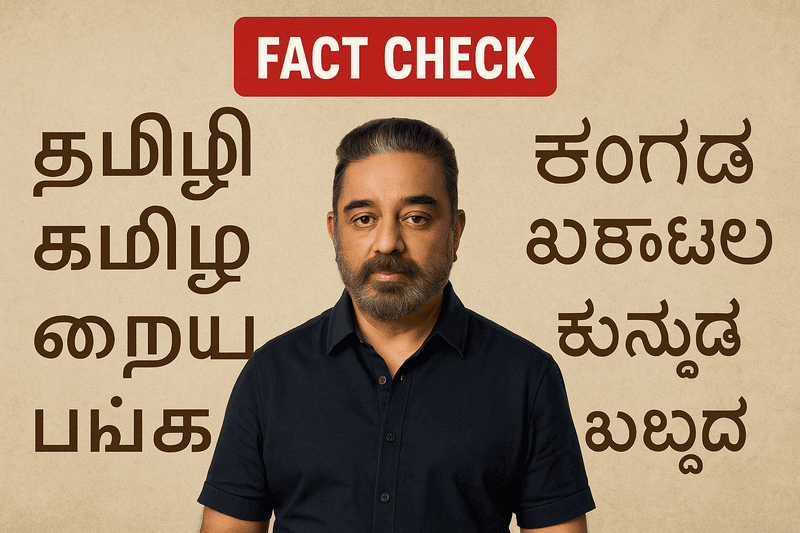The Claim
Actor and politician Kamal Haasan recently made a statement claiming that the Kannada language “was born out of Tamil,” sparking significant controversy across South India. While Haasan later said his words were misinterpreted and spoken out of love, he has refused to apologize for his remarks.
The Controversy
The statement has triggered substantial backlash in Karnataka. The Karnataka Rakshanavik filed a complaint in Bengaluru seeking an FIR against Haasan for allegedly provoking sentiments between Karnataka and Tamil Nadu. The JDS party has called for a ban on Haasan’s films in Karnataka, stating that his remarks challenge Kannada’s pride. In response, the TVK has warned of retaliatory measures, threatening to ban Kannada films in Tamil Nadu if Haasan’s movies are banned in Karnataka.
Fact Check: What Does Linguistic Science Say?
Verdict: FALSE
Modern historical linguistics does not support the claim that Kannada was “born out of Tamil.” Here are the established facts:
The Dravidian Language Family
Both Tamil and Kannada belong to the Dravidian language family, specifically the southern branch. However, they developed as separate branches from a common ancestor known as Proto-Dravidian, with their more immediate shared ancestor termed Proto-Tamil-Kannada.
Independent Development
The key facts that refute Haasan’s claim include:
- No evidence exists supporting the assertion that Kannada is born out of Tamil
- Both languages developed independently from a shared linguistic ancestor
- The split between Kannada and Tamil is older than any surviving literary or epigraphic evidence
- As Tamil remained geographically rooted in the Tamlakam region, Kannada speakers migrated westward to present-day Karnataka, leading to independent linguistic evolution
Age vs. Literary Tradition
While Tamil has an older surviving literary corpus (Sangam era, approximately 500-300 BC) compared to Kannada’s classical period (beginning around 850 CE), this difference in literary tradition does not indicate the age of the languages themselves. Linguists consider it meaningless to claim that any natural language is “older” than another, as ancestral forms of both would have been spoken simultaneously at any given historical point.
Preservation of Ancient Forms
Contrary to claims that Tamil is more “conservative” in preserving older forms, counterexamples exist. For instance, the Kannada word for “ear” (kivi) actually preserves the older Dravidian reconstructed form better than the Tamil equivalent (cevi), demonstrating that both languages have preserved different aspects of their common heritage.
Historical Complexity
The relationship between South Indian languages has been debated for centuries. A 15th-century grammar grouped languages of Kerala, Pandya, and Chola regions under “Dramida” but excluded “Karnata” and “Andhra” tongues as being too distant from Tamil. However, these historical speculations predate modern scientific linguistics.
The Bottom Line
While Tamil and Kannada share ancient roots as sister languages branching from a common Proto-Dravidian ancestor, the scientific consensus is clear: Kannada was not “born out of Tamil.” Both languages developed independently from their shared linguistic heritage, making Haasan’s claim linguistically inaccurate.
The controversy highlights the sensitivity surrounding claims of historical priority among South Indian languages and underscores the importance of distinguishing between linguistic science and regional pride. As experts suggest, such discussions require leaving linguistics to the linguists while fostering unity that avoids linguistic chauvinism.




